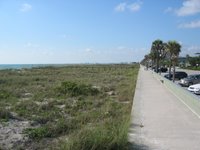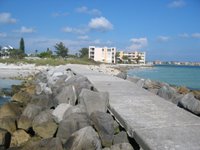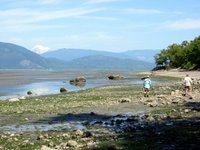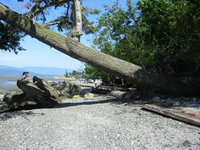
 Freeland. I've been swinging by this beach now and then to watch how it responds to the new stormwater outfall in the middle of the park (not terribly well, as the flows seem sufficient to carve a significant channel across the beach and transfer much of the sand offshore, which also results in erosion of bank adjacent to the outlet). This time, however, the beach was doing okay - other than it was blanketed with 6" of dead eelgrass. This is a typical autumn phenomenon, albeit one that varies significantly from year to year and that is probably more characteristic of some beaches than others.
Freeland. I've been swinging by this beach now and then to watch how it responds to the new stormwater outfall in the middle of the park (not terribly well, as the flows seem sufficient to carve a significant channel across the beach and transfer much of the sand offshore, which also results in erosion of bank adjacent to the outlet). This time, however, the beach was doing okay - other than it was blanketed with 6" of dead eelgrass. This is a typical autumn phenomenon, albeit one that varies significantly from year to year and that is probably more characteristic of some beaches than others.


 Lighthouse Park is at the southwest tip of Point Roberts, that little orphaned piece of the USA that hangs down below Vancouver. The high ground of Point Roberts and neighboring Tsawwassen was once an island, until subsumed by the growing Fraser Delta.
Lighthouse Park is at the southwest tip of Point Roberts, that little orphaned piece of the USA that hangs down below Vancouver. The high ground of Point Roberts and neighboring Tsawwassen was once an island, until subsumed by the growing Fraser Delta.
The west side of Point Roberts is one of the few places in the Salish Sea where humans may have managed to alter the direction of net longshore drift (there may be another smaller example northeast of the Hood Canal bridge). We can block it or reduce it, but it took the Canadians to actually reverse it. Prior to the causeways to the Tsawwassen Ferry Terminal and the Roberts Bank Delta Port, net shore drift was probably to the south, driven by the extended fetch from the north, but the causeways may provide some shelter, increasing the relative importance of southerly winds and waves. This is all pretty speculative, but makes an interesting story.
Lighthouse Park has a difficult erosion history, probably complicated by changes to wave and sediment patterns and the unfortunate location of the old lighthouse building. Seems like everything would be easier if the structure could be removed (the navigation beacon could remain) and the beach allowed to do its own thing (but then I always say that).
This visit was pleasant, but didn't match my first visit, when a kid's concert was going on at one of the shelters and a pod of Orcas headed past just offshore.
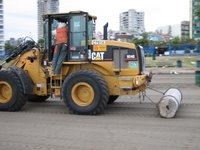
 The beaches on English Bay benefit from their orientation (using groins) and added sand. They are just one element of Vancouver's magnificent, public shoreline, and are located between Stanley Park and the dense urban neighborhood sprouting along False Bay. The 13 mile seawall path allows bikers to go from downtown around Stanley Park and False Bay all the way to Kitsilano.
The beaches on English Bay benefit from their orientation (using groins) and added sand. They are just one element of Vancouver's magnificent, public shoreline, and are located between Stanley Park and the dense urban neighborhood sprouting along False Bay. The 13 mile seawall path allows bikers to go from downtown around Stanley Park and False Bay all the way to Kitsilano.
Four evenings every summer, the beach hosts a few hundred thousand people for fireworks. Each following morning, Vancouver Parks cleans up the mess and makes the beaches look like new again, with the help of big beach toys.

 In the early 1900s, Luna Park was an amusement park on a pier - must have been a neat place on summer evenings. A couple years ago, the city fixed up the little park, removing the decaying seawall and allowing the sea to flow underneath.
In the early 1900s, Luna Park was an amusement park on a pier - must have been a neat place on summer evenings. A couple years ago, the city fixed up the little park, removing the decaying seawall and allowing the sea to flow underneath.
Harbor Avenue was once on piles over the beach, below the high bluffs of Duwamish Head. Eventually, they filled it all in, burying the original beach under the road and beach houses. Now the beach houses are five story condos, the better to stop landslides from knocking roller bladers into the Sound.


Three pocket beaches tucked into the western shore of Elliott Bay, separated by riprapped headlands of 19th century fill. The pockets probably correspond to location of wharves, where fill wasn't dumped. The coarse, well-sorted gravel leads to steep beach faces. The beaches were constructed in the late 1980s.
 In January, 1997, a family of four was killed by a landslide at this site on Bainbridge Island (see Brenda Bell's article, The Liquid Earth, in the January, 1999, Atlantic Monthly). Other nearby houses were lost to separate slides during the previous winter and in March 1997, although without the fatalities. Today, a double-tiered retaining wall is being built on the slope so the waterfront lots can be redeveloped.
In January, 1997, a family of four was killed by a landslide at this site on Bainbridge Island (see Brenda Bell's article, The Liquid Earth, in the January, 1999, Atlantic Monthly). Other nearby houses were lost to separate slides during the previous winter and in March 1997, although without the fatalities. Today, a double-tiered retaining wall is being built on the slope so the waterfront lots can be redeveloped.
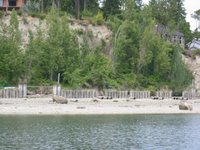
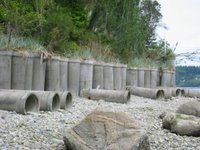 Some seawalls are special. I'm sure there is a great story to go with this one, but it's not one I've learned yet. The concrete pipe segments that remain upright are acting as planters for dune grass.
Some seawalls are special. I'm sure there is a great story to go with this one, but it's not one I've learned yet. The concrete pipe segments that remain upright are acting as planters for dune grass.

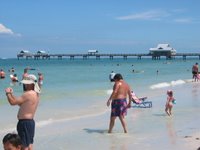 Clearwater looked to me just like a Florida Beach should look like, with sunshine, crowds, colorful umbrellas, and lots of the large multi-story hurricane deflectors built in the dunes.
Clearwater looked to me just like a Florida Beach should look like, with sunshine, crowds, colorful umbrellas, and lots of the large multi-story hurricane deflectors built in the dunes.
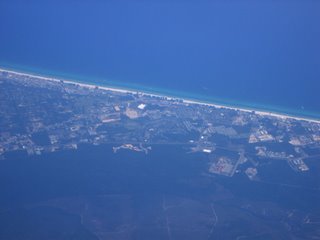 It's been thirty years since I've been in Florida, and now two trips in less than six weeks! Our time at the beach has been limited by our family's general abhorrence of hot, muggy weather, but we've managed some short excursions (for the rest of the story, go to hshipman blog).
It's been thirty years since I've been in Florida, and now two trips in less than six weeks! Our time at the beach has been limited by our family's general abhorrence of hot, muggy weather, but we've managed some short excursions (for the rest of the story, go to hshipman blog).
The flight from DFW to Tampa bypassed a large storm over New Orleans, so I didn't get good views of the coast until we got to Mobile - I was hoping for a good overview of post-Katrina Pass Christian and Biloxi. We flew a few miles north of the coastline from Mobile to Appalachicola area before cutting across the Gulf toward Tampa Bay. The photo may be Destin, though these resort beaches tend to all look the same from 35,000' (or maybe even from sea level?).
The hurricane deflectors (very small in this picture) remind me of lightning rods on the ridges of Pennsylvania barns or the wire spikes that keep seagulls off of waterfront restaurants and pigeons off of public monuments. They have been constructed up and down the southeast coast. Since hurricanes aren't very frequent, authorities let people live in them when they aren't actually being used to protect the nation from tropical storms.


This was a new one for me. It's a log crib, bolted together with stainless cable and hardware, extending out in front of the base of the bluff. It was built within the last year or so, presumably as a softer approach to erosion control than a conventional bulkhead. I'm still struggling with what to make of it. If nothing else, I wish it didn't extend so far onto the beach and that it had incorporated soil and plantings. Functionally, it appears equivalent to a failing timber seawall -- maybe that's a good thing. I wonder what the hardware will look like in 20 years?








































